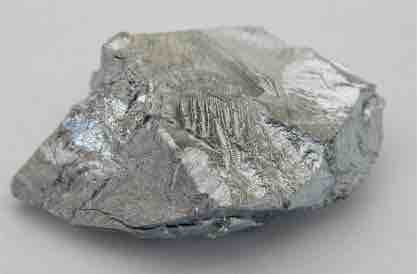Titanium, chromium, and manganese are transition metals that are used in many iron alloys to produce corrosion-resistant, durable, and lightweight steel.
Titanium
Titanium is a strong, lustrous transition metal. It has a low density, is corrosion-resistant, and has a silver color. Titanium was discovered in Cornwall, Great Britain, in 1791, by William Gregor. It was named by Martin Heinrich Klaproth, in honor of the Titans of Greek mythology.

A titanium bar
Titanium is one of the least dense, strong, and corrosion-resistant elements. It has many applications, especially in alloys with other elements such as iron. Titanium is commonly used in airplanes, golf clubs, and other objects that must be strong but lightweight.
Titanium can be alloyed with iron, aluminum, vanadium, molybdenum, and several other elements to produce strong, lightweight alloys that are used in a variety of industries, including:
- aerospace construction (jet engines, missiles, and spacecraft)
- military development
- industrial process (chemicals and petro-chemicals, desalination plants, pulp, and paper)
- the automotive industry
- the agriculture and food industry
- medical prostheses
- orthopedic implants
- dental and endodontic instruments
- dental implants
- sporting goods
- jewelry
- mobile phones
Titanium metal has two very important and useful properties: it is resistant to corrosion and it has the highest strength-to-weight ratio of any metal. In its unalloyed condition, titanium is as strong as some steels, but 45% lighter.
Chromium
Chromium is a steely-gray, lustrous, hard metal that takes a high polish and has a high melting point. It is odorless, tasteless, and malleable. The name of the element is derived from the Greek word "chrōma" (χ), meaning color, because many of its compounds are intensely colored.

Chromium
Chromium, like titanium and vanadium before it, is extremely resistant to corrosion, and is indeed one of the main components of stainless steel. Chromium also has many colorful compounds and is very commonly used in pigments, such as chrome green.
Chromium oxide was used by the Chinese in the Qin dynasty over 2,000 years ago to coat metal weapons. Weapons coated with chromium oxide were found with the Terracotta Army. Chromium was discovered as an element after 1761, when it was found in the red crystalline mineral, crocoite (lead(II) chromate). It was initially used as a pigment.
Louis Nicolas Vauquelin was the first to isolate the chromium metal from this crocoite mineral, in 1797. Following this first discovery, small amounts of native (free) chromium metal have been discovered in rare minerals, but these are not used commercially. Nearly all of the chromium that is commercially extracted is done so from the only commercially viable ore, chromite, which is also known as iron chromium oxide (FeCr2O4). Chromite is also the chief source for the chromium that is used in pigments.
Crocoite
Crocoite is a mineral formed from lead chromate (PbCrO4), a chromium compound.
Chromium metal has proven to be highly valuable due to its high corrosion resistance and hardness, particularly when steel is combined with metallic chromium to form stainless steel. Stainless steel is highly resistant to corrosion and discoloration. This application, along with chrome plating (electroplating with chromium), currently comprises 85% of the commercial use for the element. Other applications of chromium compounds account for the remaining 15%.
Manganese
Manganese is found as a free element in nature (often in combination with iron), and is also found in many minerals. It is a metal with important industrial uses, particularly in stainless steels.

Manganese
Manganese, like chromium before it, is an important component in stainless steel, preventing the iron from rusting. Manganese is often used in pigments, again like chromium. Manganese is also poisonous; if enough is inhaled, it can cause irreversible neurological damage.
Historically, manganese was named for various black minerals (such as pyrolusite) that were discovered in the same region of Magnesia in Greece. By the mid-18th century, Swedish chemist Carl Wilhelm Scheele had used pyrolusite to produce chlorine. Scheele and others were aware that pyrolusite (now known as manganese dioxide) contained a new element, but they were not able to isolate it. Johan Gottlieb Gahn was the first to isolate an impure sample of manganese metal in 1774, by reducing the dioxide with carbon.
Manganese phosphating is used as a treatment for rust and corrosion on steel. Depending on their oxidation state, manganese ions have various colors and are used industrially as pigments. Manganese dioxide is used as the cathode (electron acceptor) material in zinc-carbon and alkaline batteries.
In biology, manganese(II) ions function as cofactors for a large variety of enzymes with many functions. Manganese enzymes are particularly essential in the detoxification of superoxide free radicals in organisms that must deal with elemental oxygen. Manganese also functions in the oxygen-evolving complex of photosynthetic plants. The element is a required trace mineral for all known living organisms. If inhaled in large amounts, manganese can cause a poisonous syndrome in mammals, with neurological damage that is sometimes irreversible.